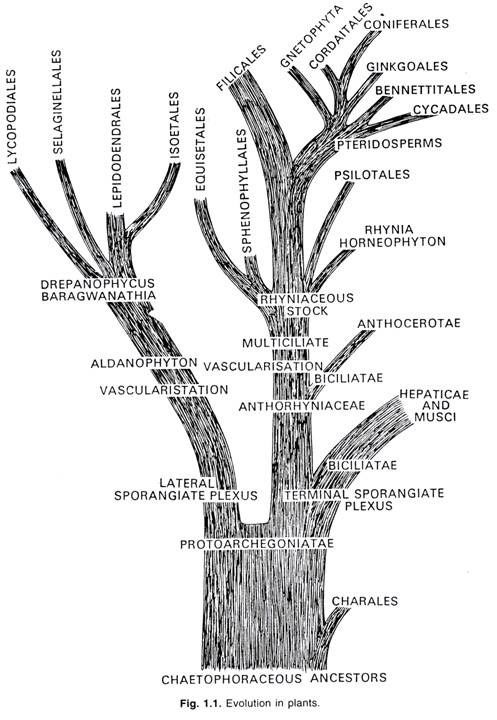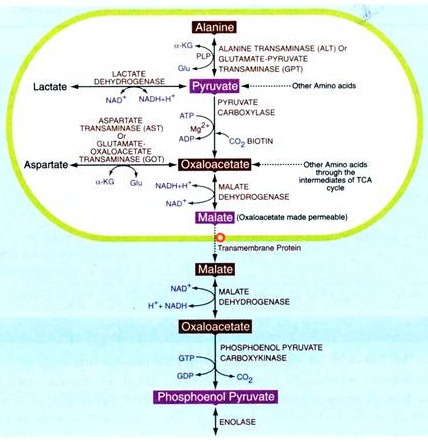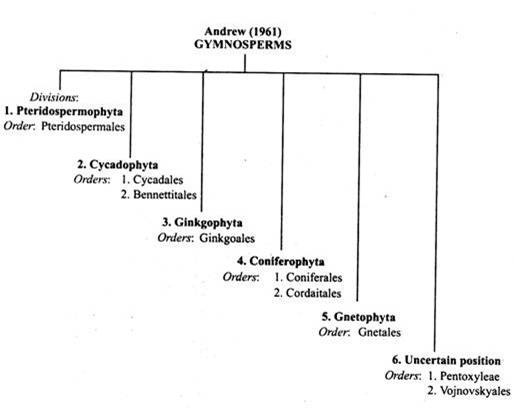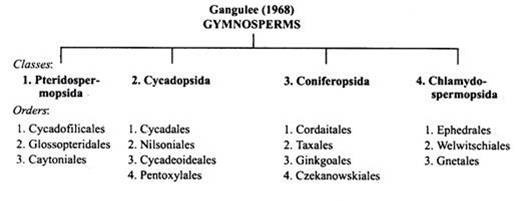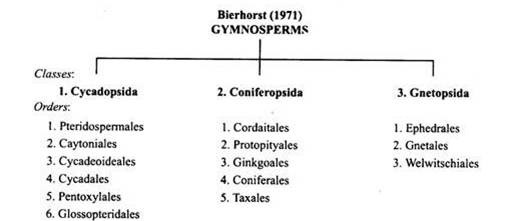ADVERTISEMENTS:
Let us learn about Gymnosperms. After reading this article you will learn about: 1. Classification of Gymnosperms 2. Main Orders of Modern Gymnosperms.
Classification of Gymnosperms:
It was generally accepted, and expressed in schemes of classification, that the Gymnospermae formed a group coordinated with the Angiospermae. From time to time suggestions have been made for splitting the Gymnospermae into a number of major groups taxonomically equivalent one to another and to the angiosperms.
Coulter and Chamberlain (1910) divided the gymnosperms into seven orders. Some of the orders are quite extinct and not found in present day.
ADVERTISEMENTS:
These orders are as follows:
1. Cycadofilicales-extinct
2. Bennettitales-extinct
3. Cycadales-Mesozoic to present day
ADVERTISEMENTS:
4. Cordaitales-extinct
5. Ginkgoales-Palaeozoic to present day
6. Coniferales-Palaeozoic to present day
7. Gnetales-Recent.
Chamberlain (1934) however, divided the gymnosperms into two large groups A. Cycadophyta and B. Coniferophyta.
In the Cycadophyta, sporophylls are in cones.
They include three orders:
Cycadofilicales (Pteridospermae)-extinct
Bennettitales (Cycadeoideales)-extinct
ADVERTISEMENTS:
Cycadales-Mesozoic to present day.
The Coniferophyta is divided into four orders:
Ginkgoales-Palaeozoic to present day.
Cordaitales-extinct
ADVERTISEMENTS:
Coniferales-Palaeozoic to present day
Gnetales-Recent.
Prof. B. Sahni (1920) divided the gymnosperms into two large groups and gave them the terms:
1. Phyllospermae and
ADVERTISEMENTS:
2. Stachyospermae.
1. Phyllospermae:
They comprise of the Pteridosperms and the Cycadophyta (Cycadales and Bennettitales). The seeds are being inserted on the modified leaves.
2. Stachyospermae:
ADVERTISEMENTS:
This group includes the orders of Coniferophyta of Chamberlam. They are more or less microphyllous plants with seed inserted on the stems.
Raizada and Sahni (1938) have summarized the classification of gymnosperms as follows:
Cycadophytes:
Pteridospermae (Cycadofilicales)-Carboniferous. Extinct.
Cycadeoideales (Bennettitales)-Mesozoic. Extinct.
Cycadales-Mesozoic to present day.
ADVERTISEMENTS:
Pentoxylales: Jurassic
Coniferophytes:
Cordaitales-Palaeozoic. Exinct
Ginkgoales-Palaeozoic to present day.
Coniferales-Palaeozoic-Mesozoic to present day
Gnetales-Recent.
ADVERTISEMENTS:
The characteristic features of these orders are as follows:
1. Pteriodspermales (Cycadofilicales):
Trees or small plants with fem-like leaves. Sporangia borne on frond-like leaves, more or less modified, but never formed a cone.
2. Cycadeoideales (Bennettitales):
Trees with stems covered with an armour of persistent leaf bases. Male sporophylls frond-like forming a loose crown. Female sporophylls found in a cone-like structure, no longer leaf-like.
3. Cycadales:
Plants with palm-like habit, male and female sporophylls grouped into cones, except in the genus Cycas where the female sporophylls are collected into a loose crown. Male cells (gametes) motile.
4. Pentoxylales:
Low shrubs. Female inflorescence consisting of numerous cones spirally attached on a peduncle, each bearing numerous ovules on a central axis. No megasporophylls, ovuliferous scales or inter-seminal scales. Male flowers terminally borne on dwarf shoots. Unilocular sporangia terminate short branchlets of the appendages or microsprophylls.
5. Cordaitales:
Large trees with flat strap-shaped leaves. Fructifications in cones.
6. Coniferales:
Large trees or shrubs. Leaves needle or scale-like, sometimes flattened, male cells never motile. The male flowers are arranged in more or less compact clusters or catkins and female flowers are usually clustered to form a cone.
7. Ginkgoales:
Medium sized trees. Leaves flattened and lobed in various ways with dichotomous venation. Male and female flowers collected into strobili.
8. Gnetales:
Small trees or shrubs or climbing shrubs. Opposite leaves, dicotyledonous embryos and compound cones in both male and female.
Modern taxonomy divides the gymnosperms into six or seven classes or orders.
These classes or orders are as follows:
1. Pteridospermae (Cycadofilicales)
2. Cycadinae (Cycadales)
3. Bennettinae (Bennettitales)
4. Cordaitinae (Cordaitales)
5. Ginkgoinae (Ginkgoales)
6. Coniferae (Coniferales)
7. Chlamydospermae (Gnetales)
From the view point of their phylogeny the Gnetales or Chlamydospermae are placed intermediate between the gymnosperms and the angiosperms. Though the order includes three families yet recently several authors raised the families to the rank of orders because of the divergence in the characters of the genera belonging to them. The orders are—Ephedrales, Gnetales and Welwitschiales.
Economic Importance of Gymnosperms:
Economically the gymnosperms are of very great importance in providing timber and wood pulp and they are planted in many parts of the world under schemes of forestation and reafforestation. The Coniferales are the most important order of forest trees in the economy of civilized man. Their timber is of universal importance. Coniferous timber is the cheapest and the best.
It is none to second in durability, lightness, elasticity and fineness.
The family Pinaceae in particular is of great importance as far as the production of timber and resin is concerned. In the coniferous-pine forests of Himalayan region-Northern India the resin is collected on commercial scale. Resin and turpentine are a source of immense revenue to India.
Cedrus deodara (Deodar) is the strongest of the Indian coniferous woods and is in great demand for construction work and furniture. The railway sleepers are made from deodar wood.
The Government of India is keeping in view to manufacture newsprint out of fir and Himalayan spruce to save a lot of foreign exchange. Large quantities of fir and spruce are available in Kashmir, Himachal Pradesh and Tehri-Garhwal region.
The annual revenue from the sale of pine resin from the Government owned coniferous forests of Kashmir, Himachal Pradesh, Uttar Pradesh, West Bengal and Assam is immense and millions of rupees. The revenue derived from the sale of coniferous timber of Government owned forests of above mentioned states adds much to the economy of country.
Main Orders of Modern Gymnosperms:
The modern gymnosperms are commonly grouped under four orders:
1. Cycadales;
2. Ginkgoales;
3. Coniferales and
4. Gnetales
The Cycadales and the Ginkgoales include living members which have a long, fossil history and can be regarded as ‘living fossils’. Ginkgoales in the past (early Mesozoic) were represented by widely distributed group of plants, but now the order is represented by a single species Ginkgo biloba.
In the similar way Cycadales flourished well during the Mesozoic and are now represented by nine well defined genera that are confined to limited areas in the tropical and subtropical countries of the world.
The Coniferales from the most conspicuous order of the living gymnosperms and include the plants like Pinus, Cedrus, Abies, Juniperus, Cupressus, Biota, etc.
Some conifers are the world’s tallest and long-lived plants, e.g., Sequoia gigantea lives for 4,000 years and grows very tall (300 to 400 feet in height). The conifers are cosmopolitan and widely distributed throughout the northern and southern hemispheres of the globe and form extensive forests.
The Gnetales are represented by three living genera, e.g., Gnetum, Ephedra and Welwitschia.
Genus Welwitschia is monotypic and represented by W. mirabilis. This is found in deserts of South-West Africa. Ephedra (30 – 40 species) has many species that are distributed in tropical and temperate regions of Asia, Africa and South America.
Besides, the coniferous forests provide a cool and soothing climate suitable for health. Several health resorts and sanatoria run in the hills under the shadow of pine trees where hundreds of people and patients go every year for recreation and treatment.
The pith of Cycas revoluta yields sago, and thus, the plant is called the sago palm. The seeds of Pinus gerardiana are edible and known as chilgoza. They are generally found in the dry arid zones of Himalayas. The famous drug known as epedrine is obtained from different species of genus Ephedra. The young leaves and strobili of Gnetum are eaten as vegetable.
Evolution of Gymnosperms:
However, the gymnosperms are not in such an advantageous position because:
(i) They lack vegetative means of reproduction by means of cuttings, layering, etc. and are slow growing.
(ii) Limited means of dispersal (only wind and by man) and their failure to grow under varied habitats.
(iii) Absence of vessels in xylem and of companion cells in the phloem.
(iv) Absence of bisexuality which reduces the chances of self-fertilisation and lot of pollens are wasted, as wind-pollination is the main source of carrying pollen grains,
(v) Unprotected ovules and seeds.
(vi) Their decline may also be due to the running out of the gene potential for environmental adaptation and appearance of certain harmful mutations and chromosomal alterations.
(vii) Economically too they are less important in comparison of angiosperms.
The gymnosperms are the most ancient seed plants that originated during the late Palaeozoic (i.e., 350 million years ago from the upper Devonian to the present) era, but flourished well during the Mesozoic. Their long evolutionary history is full of diverse lines of evolution within the group, during which many organisms flourished and then became extinct.
Most of them had fernlike general appearance and foliage but possessed the primitive type of seed. The seeds were found attached to the pinnatifid fronds, e.g., Medullosa noei.

